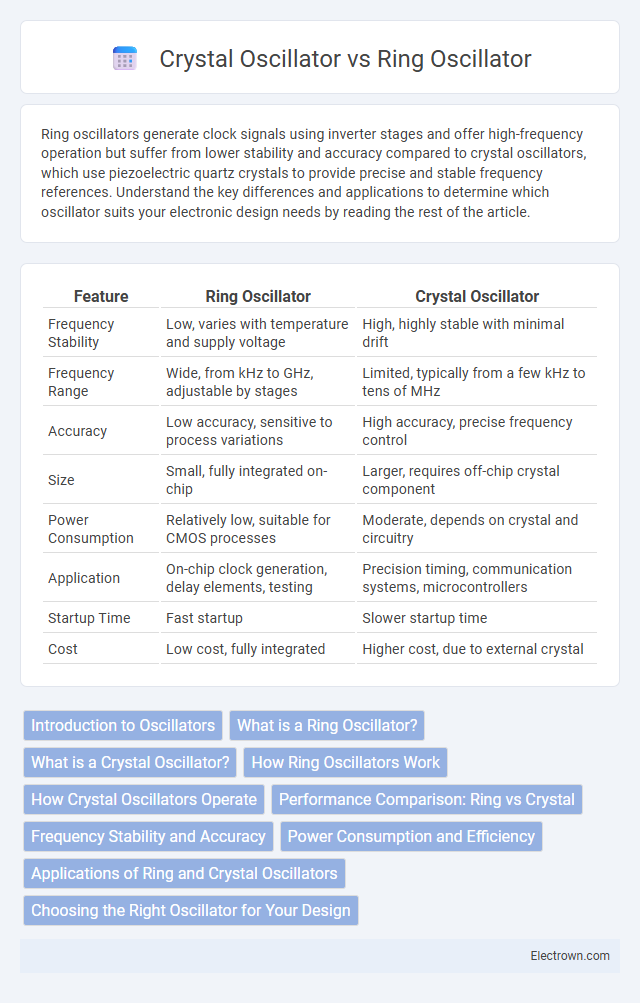Ring oscillators generate clock signals using inverter stages and offer high-frequency operation but suffer from lower stability and accuracy compared to crystal oscillators, which use piezoelectric quartz crystals to provide precise and stable frequency references. Understand the key differences and applications to determine which oscillator suits your electronic design needs by reading the rest of the article.
Table of Comparison
| Feature | Ring Oscillator | Crystal Oscillator |
|---|---|---|
| Frequency Stability | Low, varies with temperature and supply voltage | High, highly stable with minimal drift |
| Frequency Range | Wide, from kHz to GHz, adjustable by stages | Limited, typically from a few kHz to tens of MHz |
| Accuracy | Low accuracy, sensitive to process variations | High accuracy, precise frequency control |
| Size | Small, fully integrated on-chip | Larger, requires off-chip crystal component |
| Power Consumption | Relatively low, suitable for CMOS processes | Moderate, depends on crystal and circuitry |
| Application | On-chip clock generation, delay elements, testing | Precision timing, communication systems, microcontrollers |
| Startup Time | Fast startup | Slower startup time |
| Cost | Low cost, fully integrated | Higher cost, due to external crystal |
Introduction to Oscillators
Oscillators generate periodic signals essential for timing in electronic circuits, with ring oscillators using inverters arranged in a loop to produce oscillations and crystal oscillators relying on the mechanical resonance of a piezoelectric crystal for stable frequency output. Ring oscillators offer simple integration and tunable frequencies but suffer from lower accuracy and higher phase noise compared to crystal oscillators, which provide precise, stable frequencies ideal for communication and timing applications. Selection depends on requirements for frequency stability, power consumption, and circuit complexity.
What is a Ring Oscillator?
A ring oscillator is a device composed of an odd number of inverters connected in a loop, generating oscillations through the continual inversion of logic states. It produces a frequency determined primarily by the propagation delay of each inverter stage, making it highly sensitive to process, voltage, and temperature variations. Unlike crystal oscillators, ring oscillators offer simpler integration in ICs but lack the frequency stability and precision required for applications demanding accurate timing.
What is a Crystal Oscillator?
A crystal oscillator is an electronic oscillator circuit that uses the mechanical resonance of a vibrating quartz crystal to generate a precise frequency signal. Known for its high stability and accuracy, crystal oscillators are widely used in clocks, microprocessors, and communication systems to provide a reliable timing reference. Compared to ring oscillators, crystal oscillators offer superior frequency precision due to the quartz crystal's stable resonant frequency.
How Ring Oscillators Work
Ring oscillators consist of an odd number of inverter stages connected in a loop, creating a feedback path that produces oscillations by continuously inverting the signal. The oscillation frequency depends on the propagation delay of each inverter and the total number of stages, which makes ring oscillators inherently variable and sensitive to temperature and supply voltage. Unlike crystal oscillators that rely on piezoelectric resonators for stable frequency, ring oscillators generate signals purely through digital circuit delays, making them suitable for integrated circuits requiring tunable or on-chip clock sources.
How Crystal Oscillators Operate
Crystal oscillators operate based on the piezoelectric effect, where a quartz crystal vibrates at a precise frequency when an electric field is applied. This vibration generates a stable and accurate oscillation signal used to control timing in electronic circuits. Your devices rely on this consistent frequency to maintain accurate clock signals, ensuring reliable performance in applications like communication systems and microprocessors.
Performance Comparison: Ring vs Crystal
Ring oscillators offer high-frequency operation and ease of integration on ICs but suffer from poor frequency stability and higher phase noise compared to crystal oscillators. Crystal oscillators provide superior frequency accuracy, stability, and low jitter, ideal for precise timing in communication and instrumentation systems. Your choice depends on the application requirements, balancing cost, integration complexity, and performance needs.
Frequency Stability and Accuracy
Ring oscillators exhibit lower frequency stability and accuracy due to variations in temperature, voltage, and process, causing frequency drift and jitter over time. Crystal oscillators provide superior frequency stability and precision by utilizing the piezoelectric properties of quartz crystals, maintaining consistent oscillation frequency under varying environmental conditions. Your choice depends on the application's tolerance for frequency variation, where crystal oscillators are preferred for high-accuracy timing requirements.
Power Consumption and Efficiency
Ring oscillators typically consume more power due to their continuous switching of inverter stages, making them less efficient for low-power applications. Crystal oscillators leverage the mechanical resonance of quartz crystals, resulting in significantly lower power consumption and higher frequency stability. Their efficiency makes crystal oscillators ideal for battery-powered and precision timing devices.
Applications of Ring and Crystal Oscillators
Ring oscillators are widely used in integrated circuits for timing verification, delay characterization, and as clock sources in low-frequency applications due to their compact size and ease of integration. Crystal oscillators are preferred in applications requiring high frequency stability and precision, such as communication systems, GPS devices, and microcontroller clocks. The superior frequency accuracy of crystal oscillators makes them ideal for timekeeping and frequency reference standards in industrial and consumer electronics.
Choosing the Right Oscillator for Your Design
Choosing the right oscillator for your design depends on factors such as frequency stability, power consumption, and size constraints. Ring oscillators offer simplicity, low cost, and compact size but have lower stability and higher phase noise, making them suitable for integrated circuit applications where precision is less critical. Crystal oscillators provide excellent frequency stability and low phase noise, ideal for applications requiring accurate timing and long-term reliability.
Ring Oscillator vs Crystal Oscillator Infographic

 electrown.com
electrown.com